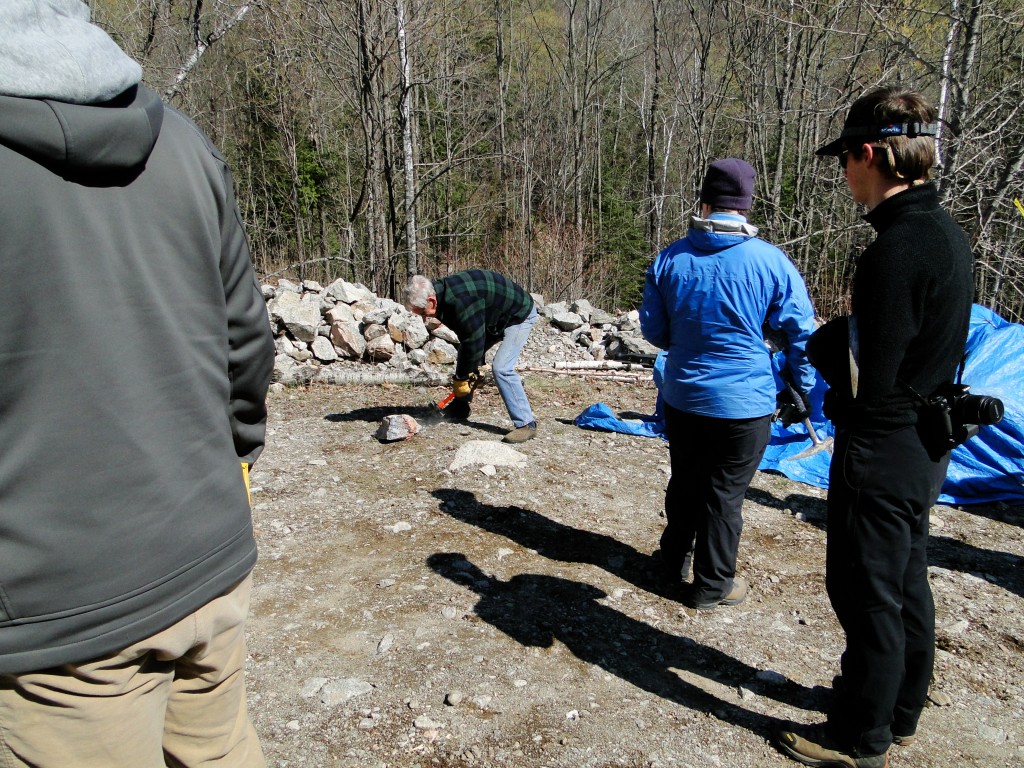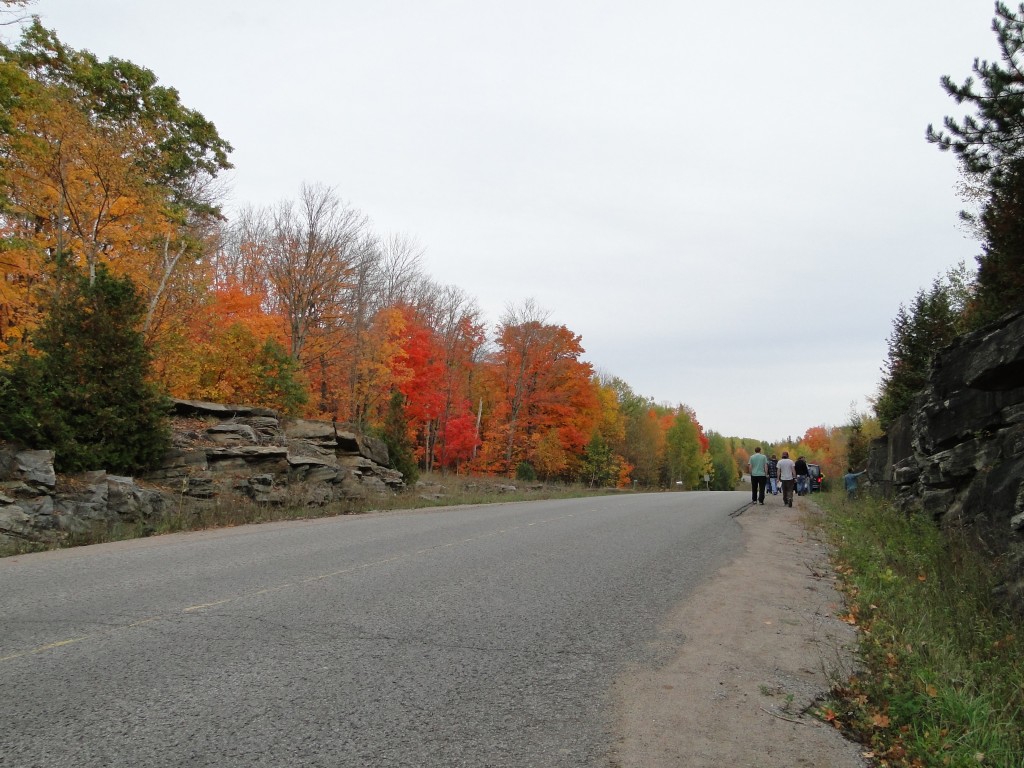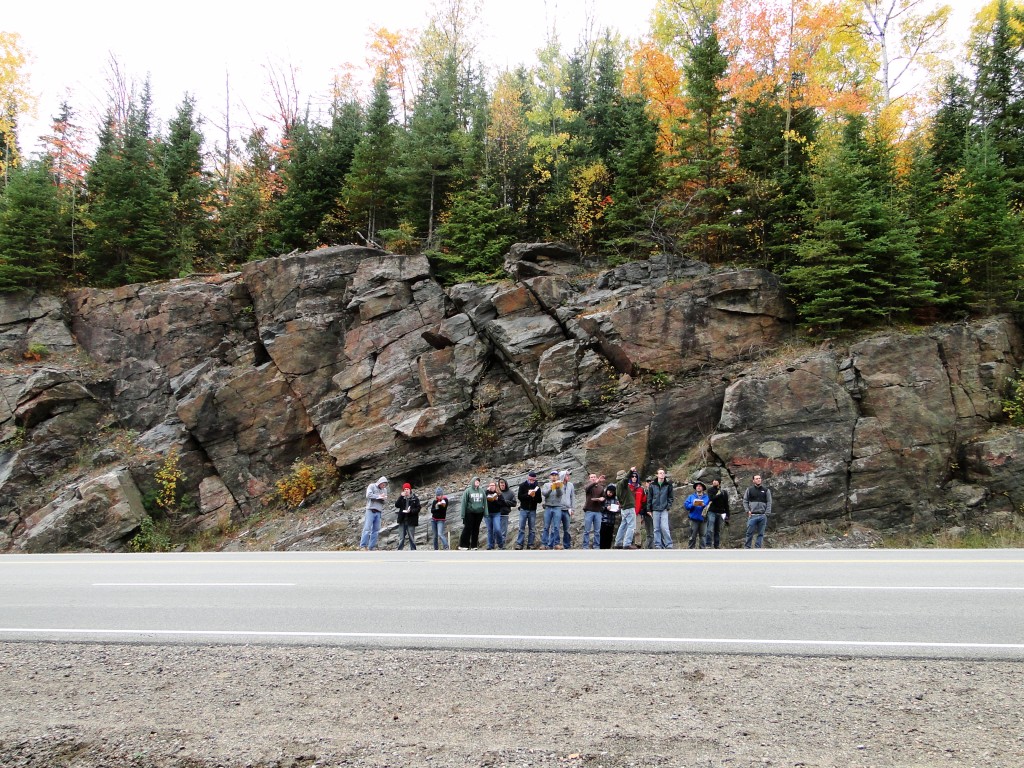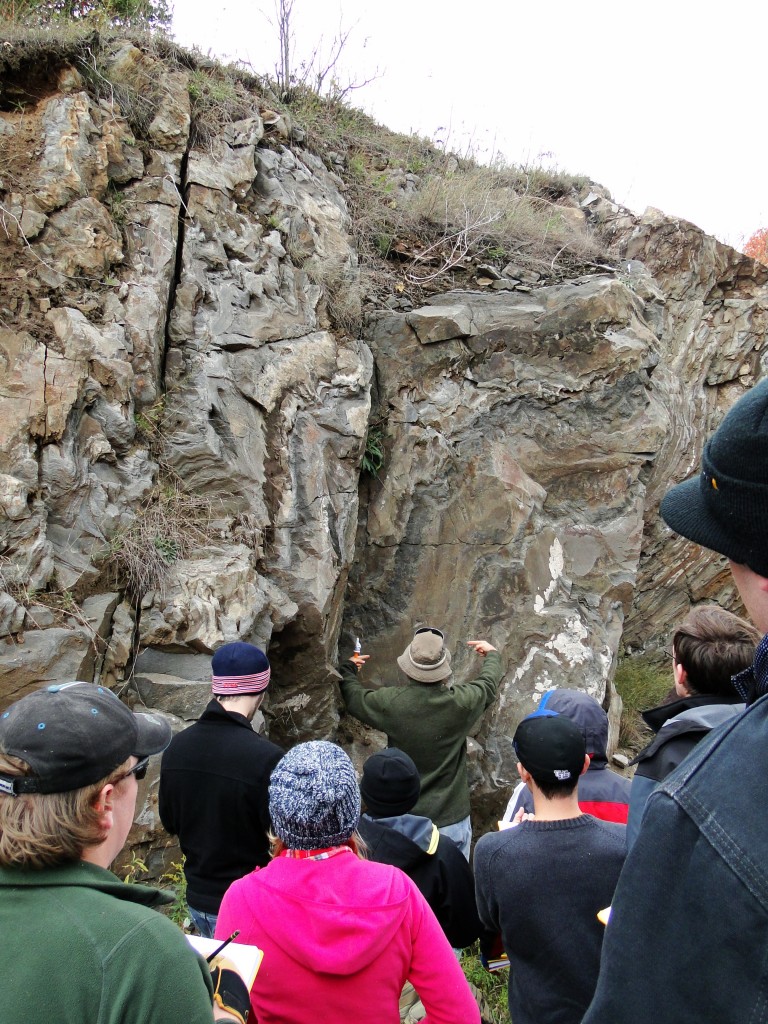12 October 2012
Field trip etiquette
Posted by Jessica Ball
On keeping good field notes:
If someone is giving you the “answers” about an outcrop, keep those separate too (under some heading like ‘lecturer notes’). This is important, because you have not done the work that led to those answers. If you don’t indicate where they came from, you may go back to a set of notes years later and you won’t know how you knew all this cool stuff about the site.

We don't always remember our safety glasses, but we're not standing right next to the person with the sledgehammer!
On standing around/hammering/collecting:
Be aware of where you are. Are you at a roadcut (likely)? There are going to be cars. Stay out of the road unless you’re crossing it. Pay attention to where you’re standing – the road is not your personal lounge area.
Be kind to the outcrop and don’t hammer unnecessarily! Hammering on things is fun, but when you use your rock hammer, you are destroying an outcrop that others may want to see. If possible, do your collecting from material that has already fallen off (there will almost always be bits laying around).
Be aware of where other people are when you hammer. Breaking rocks creates a lot of flying material which can (and does) end up hitting people in the eyes, face, whatever. Tell your colleagues to back away or go hammer on your rock somewhere away from the rest of the group.
Hammer wisely. Pick a bit of the outcrop that you are reasonably sure will break off. Don’t just whale away at a flat or massive rock face, because it’s a waste of time and makes it look awful.
Be aware of whether or not collecting is allowed. It isn’t? Don’t have your hammer out and don’t go around stuffing your pockets. Respect local, state, regional regulations – and if it’s a special outcrop, remember that we want it to be there for future geologists to see as well.

Sometimes we do have to park on narrow shoulders, but we try to stay out of the road. (Our schools generally frown on students getting run over by cars.)
For those of you who aren’t lucky enough to come on geology field trips with us, don’t worry – I’ve got some advice for you as a passer-by!
Give us a little space – if you can, slow down and/or move over a bit! We’ll try to park out of the way of traffic, but sometimes we have to use narrow shoulders when we’re visiting a roadcut. We really appreciate it when we don’t have to reattach mirrors or scrape careless students up off the pavement.
Please don’t honk at us! We know you’re there, really. We can hear your car coming, often long before you see us. But honking is startling and no one likes that adrenaline rush when they’re trying to measure something or take detailed notes. If you feel the need to acknowledge our presence, wave instead – you’re a lot less likely to end up with a field notebook plastered across your windshield because you’ve scared a student.
We’re happy to talk to you, especially if you own the land near the outcrop we’re looking at or are just interested in geology in general. Try to approach the instructor of the trip (usually the person waving their arms and shouting more than anyone else) and introduce yourself before talking with the students – they’re often busy with their notes. If you are concerned about ‘geologist erosion’ at the outcrop, let us know politely, without being confrontational. We try to make sure that we have permission to be on private land or collecting at our stops, but occasionally we slip up. We’re only human!





 Jessica Ball is a volcanologist at the U.S. Geological Survey, researching volcanic hydrothermal systems and stability, and doing science communication for the California Volcano Observatory. She previously worked at the Geological Society of America's Washington DC Policy Office, learning about the intersection of Earth science and legislative affairs. Her Mendenhall postdoc and PhD focused on how water affects the stability of volcanoes, and involved both field investigations and numerical modeling applications. Her blogging covers a range of topics, from her experiences in academic geosciences to science outreach and communication to her field and lab work in volcanology.
Jessica Ball is a volcanologist at the U.S. Geological Survey, researching volcanic hydrothermal systems and stability, and doing science communication for the California Volcano Observatory. She previously worked at the Geological Society of America's Washington DC Policy Office, learning about the intersection of Earth science and legislative affairs. Her Mendenhall postdoc and PhD focused on how water affects the stability of volcanoes, and involved both field investigations and numerical modeling applications. Her blogging covers a range of topics, from her experiences in academic geosciences to science outreach and communication to her field and lab work in volcanology.
Some stuff I added with students, for safety’s sake: 1) Be aware of and keep an eye on what’s above you. Try to avoid places along outcrop where there’s loose or crumbly material much above head level 2) Re: traffic, it’s easy to get so focused on what you’re doing that you aren’t paying attention. Probably trues with kids than adults, but I had them yell out “car” when they heard or saw one coming. 3) No climbing. Not only can climbing dislodge stuff above your head, it’s less likely you’ll fall off the ground than a cliff face. 4) It’s fine to take samples of interest, and ones you’ll use- either for illustration and your own education or for teaching and communicating with others- but don’t take more than you need.
Nice foliage.
I second Lockwood’s “No climbing” rule. Too many students see a rock face and think the best thing to do is become an expert rock climber. I’ve seen too many falls/near falls from their situations.
Agreed. I rarely scale outcrops, and never directly – if I’m on top of one, it’s usually because it was possible to walk up a back way. I’ve never seen any falls, but I do often see injuries in the making when someone higher up on an outcrop knocks rocks down onto lower people. (Goes right back to the ‘hammer safely’ rule…)
If you work along the road, it is best to wear those flashy-yellow safety light jacket (the one you may already have in your car).
I know: not very cute. Students who will work in the industry will have to wear them at work (and may have the responsability to have coworkers wear them), so start the good habit.
You may think you would hear the cars, but that is not always the case (wind, electric car, whatever…) and you certainly will not hear CYCLISTS. In the mountains of South of France, it is a very real danger! They may ride at over 30 miles per hour…. Never ever walk backward from the outcrop (to get a larger view) with your back towards the road…
Thanks for the posts. Have nice field trips
Another suggestion: stay with the group. We had a guy that insisted on wandering off at all times and we wasted a lot of time on mini search and rescue operations.